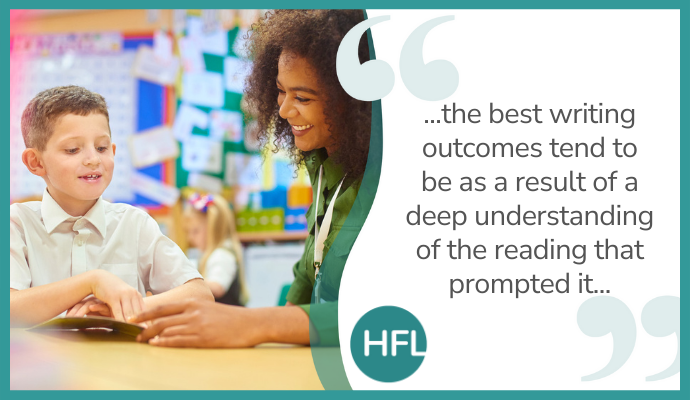
This blog will explore the link between active reading and developing vocabulary which is also a link between reading and writing. Many schools are currently focused on their writing standards after a couple of years of focus on reading. In reality, we need to pair the two. As we know, the best writing outcomes tend to be as a result of a deep understanding of the reading that prompted it (whether that be text, film or picture). Having that deep understanding of authorial intent, can then support children to ensure that the reader is foremost in their mind as they write. They will have been taught a wide range of grammatical skills with which to craft their writing and with focused authorial intent, they can hook, interest and perhaps even delight their reader.
Before beginning, I will explain my interpretation of ‘active reading’ and also ‘vocabulary’ for the purposes of this blog.
To consider active reading strategies, let’s first consider those children who can read every word on the page and yet struggle to discuss what they have read. Phonic teaching has worked for them. They can decode and some of them with increasing accuracy. However, as a member of the Reading Fluency team, I, like the others, have asked myself – do they sound good to listen to? Does it sound as if they understand what they are reading? Often, the answer is no. This can be due to lack of active reading. We need to ensure the children stay alert while reading and use a range of strategies to check that they understand. They will do this by bringing the content to life as they read; questioning what they read (that internal monologue e.g. ‘I wonder if…’ or ‘Why did he do that?’ etc). As teachers, we have to model our inner monologue often so that all of the children realise that you are reading with a ‘busy brain’. Checking that everything they read makes sense. One strategy to combat passive reading – just reading the words because you have been asked to - is to ask the children to visualise: picture what you are reading as you read. This alone makes a remarkable difference. One of the key indicators that this is working is when children begin to self-correct. The other day, I was reading the national curriculum for primary English (well it is my job), and I read ‘elephants’. It brought me up short because I know there are no elephants in there. The word was ‘elements’. As I was expecting what I was reading to make sense, this flagged up immediately. However, I’m sure, like me, you’ve all read with a child who would just continue reading. So, by active reading, I mean bringing it to life, making sense of it as we go.
Now to define what I mean by ‘vocabulary’ - not a term we would usually clarify. However, from conversations with children and displays in classrooms, I believe vocabulary is often seen as isolated words. As a team, we have decided to speak about ‘language’ rather than ‘vocabulary’. In the past, I have asked a child to read through a text, underline any words they don’t know or are not sure about, look them up in a dictionary and perhaps thesaurus. I would then ask them to write the words into sentences of their own, giving a good gauge of the child’s understanding and they will have learned how to use more words. However, if during this exercise a KS2 child were to read ‘It was a cutting remark’, and not fully understand it, they are unlikely to give the word ‘cutting’ the same level of attention. For this reason, it’s an idea to tweak your language in class and ask children to identify anything in the text that ‘doesn’t make sense’. You may be familiar with the DfE KS1 reading exemplification based on a reading of ‘The Tear Thief’ by Carol Anne Duffy. In the transcript, the teacher asks the child what they believe the author was saying when they said the ‘Tear Thief had sharp hearing’. The child’s response was focused around the Tear Thief having pointy ears. At this point, the child may think it still makes sense but it’s a good indicator to the teacher that they did not understand the language and thus the authorial intent.
The following is an example of embedding active reading strategies and engaging with the language to draw through into the children’s writing. In this instance, drama is that linchpin between reading and writing.
Let’s look at some extracts from well-known novels and consider what this would look like in the classroom. My suggestion is to model active reading as often as possible. Show the children how to remain alert while reading. You model this by slowing down the process in your own head and telling the children what is happening in your mind as you read, e.g. visualising, questioning, predicting. Whenever possible, linger to use drama to bring some of the language to life. Verbs and adverbs offer a fabulous opportunity for this. For instance, in this extract below from Neil Gaiman’s ‘The Graveyard Book’, I would ask a child to ‘slip’ out of the door (or I might model it myself). I might ask two children to ‘slither and twine’ themselves through the legs of a table and ask another to ‘pause’ to watch. When the children are used to this, it doesn’t take too much time.
The street door was still open, just a little, where the knife and the man who held it had slipped in, and wisps of night-time mist slithered and twined into the house through the open door.
The man Jack paused on the landing.
I might do even more at this point. I may want to further deepen the children’s language knowledge by introducing more vocabulary. For instance, I could introduce a list of 10 verbs (and/or verb phrases) and ask them to consider which of these might also be appropriate to show how the mist is moving (perhaps in a zone of relevance). They might order them from most creepy to least creepy. They could act them out. They could try them out in sentences of their own and then read expressively to a partner to consider the effect. I would then ask the children to re-read the original text with ‘busy brains’ bringing the scene to life.
It’s not just fiction that can be brought to life in this way. There are so many lovely, language-rich non-fiction texts for us to use in school today too.
As I was writing this blog and rethinking the process, I realised that I had an acronym: AARDVARK
Active
Alert
Reading
Drama
Vocabulary (language)
Active (returning to the original text / and/or actively reading their own text).
Reading
Knowledge (building their understanding and use of language)
We have heard and, I’m sure, used the term ‘pleasure for reading’ many times in recent years. Let’s build this pleasure through reading lessons where children learn the joy of lingering in books and bringing them to life. Let’s be more AARDVARK!



